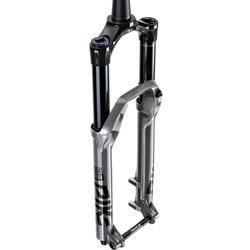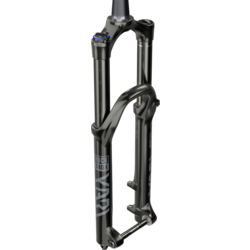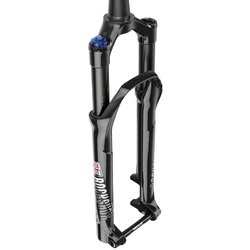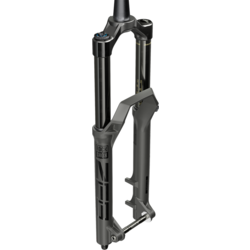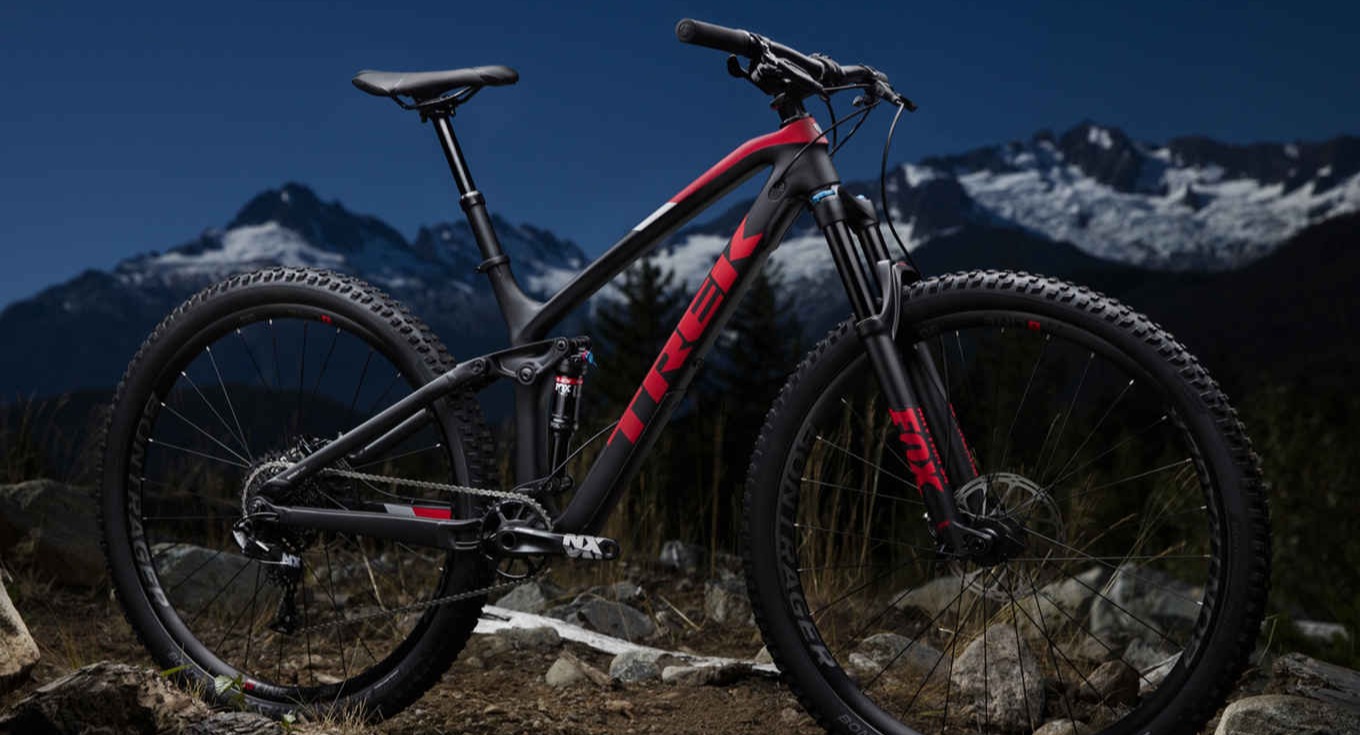
In this picture the front and rear shocks are clearly visible on this dual suspension rig. This thing can eat bumps like cookie monster eats cookies!
Bike Suspension 101
Suspension forks and shocks allow you to ride your bike over rough terrain with more comfort, safety and stability.
Rough singletrack & choppy roads become much easier to manage due to your bike's suspension absorbing the hits.
Having suspension on your bike greatly adds to your enjoyment level while riding on rough or uneven ground.
In this guide we'll go into the basics of bike suspension for new bike shoppers or anyone looking to upgrade their current bike to a suspension bike.
We will also get into how suspension works and finally get into setup & suggested maintenance.
Dual Suspension Mountain Bike Vs. Front Suspension?
Generally speaking, bikes either have front suspension or dual suspension (shocks front and rear).
Usually it's a mountain bike that has suspension but in today's world there are other types of bikes with suspension on them as well.
Dual sport hybrids and even some road bikes are coming with some type of suspension added to them to smooth out the the ride these days.
So, when shopping for a new bike with suspension you will have the option of one shock or two depending on your usage and budget.
Bikes with shocks on the front only are generally referred to as hardtails while bikes with suspension shocks front and rear are referred to as dual suspension bikes.
Hardtails have a lower upfront cost and may be a bit lighter than dual suspension bikes.
Dual suspension bikes are more at home on rougher trails than their hardtail brethren but come with a higher entry cost and a slight weight penalty due to their extra moving parts. However, the added weight and cost are welcomed side effects due to a dually's added trail chops when things get rough.
This video will help explain the differences between dual suspension mountain bikes and hardtails. (video courtesy of Trek Bikes)
Looking To Upgrade Your Suspension Fork Or Rear Shock?
- If you are looking to upgrade your current suspension fork there are a few things you'll need to know.
- What type of axle does your current front wheel have? Is it thru axle or standard quick release?
- What diameter is the headtube of your bike that you are looking to upgrade? Some of the newer suspension forks may not be compatible with slightly older bikes due to changes in headtube diameters in recent years. Most older bikes ran an 1 1/8" steerer diameter while even older bike were built with a 1" diameter steerer tube in mind. Many newer bikes are now running a tapered headtube and steerer set up, 1.5" diameter on the bottom and 1 1/8" up top for more stiffness while steering. Your local shop can help determine what setup you need for your bike.
- How much travel are you looking to get out of your new fork? Most bike manufaturers limit how much travel their frames can handle before it becomes unsafe or becomes a detriment to the bike's handling characteristics. If you put too much travel on a frame that wasn't meant to handle it, the frame may even break!
- What type of brake does your bike currently have on it? If you don't currently have a disc brake on your bike this may be a great chance to upgrade your brake as well and gain more stopping power. However, be aware that when you do upgrade to disc brakes you very well may need a new wheel to allow you to mount the brake rotor to your wheel as well as the new disc brake caliper of course.
- If your're upgrading your rear suspension you'll need to know your bike's factory specs, including eye to eye length of the shock, spacing for your mounting hardware and the suggested stroke of the shock itself so as not alter your bike's geometry in a negative way.
More Money Equals More Performance
When shopping for new bike suspension there's a few things to keep in mind when coming up with a budget for what you want to spend on a new set up.
- Overall Quality : Higher end suspension is better made, using better materials and as a result will need less upkeep and generally will last longer than lower end models.
- Weight : Generally speaking, the more you spend the lighter you get. Of course weight is also tied to the amount of travel you're looking for and the type of riding you'll be doing.
- Adjustments : More pricey suspension forks & shocks give you the option of more adjustments. Most higher priced options now give you a "lock out" option that allows you to turn your suspension rigid or "locked out" with the press of a button or flip of a lever.
- Ride Quality : Higher priced suspension just works better due to it's lighter weight, better materials and more adjustments to really dial in your preferred ride characteristics.
Suspension Fork Parts Diagram
- When talking suspension there are several terms that you will run across quite often.
#1 - The term "Fork" or "Suspension Fork" refers to the front suspension of a bike.
#2 - Steerer Tube : Holds the fork in the bike at the headtube. 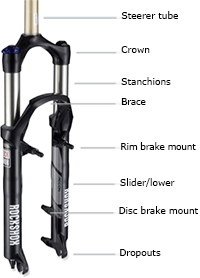
#3 - Crown : Upper cross piece of the fork, it holds the stanchions in place.
#4 - Stanchions : These travel in and out of the lowers of the fork and house the fork's intrenals.
#5 - Lowers/Sliders : The lower section of the fork into which the stantions attach, also is where your brakes mount to the fork.
#6 - Drop Outs : Where your wheel attaches via a quick release or thru axle.
#7 - Brake Mount : Where you brakes attach to the fork, style varies form brand to brand.
What Is Suspension Travel?
"Travel" is how far a fork can compress to absorb a hit or when it is fully compressed.
The amount of travel varies depending on the fork's intended use.
A rider looking to ride down mountains would look for the most travel available while a rider who is riding more tame and generally less aggressive terrain would opt for a lesser travel suspension setup.
Generally speaking, bikes will come stock with suspension best adapted to a bike's intended use.
Hybrid style bikes with suspension will generally come with 2-3" of travel.
Cross country or short travel mountain bikes come with 4-5" of travel.
All mountain or aggressive long travel trail bikes come with 5-6" travel.
Downhill or freeride/enduro bikes can come with over 7" of travel!
Suspension Maintenance & Service
Your bike's suspension does a ton of moving and like all things that move, suspension needs periodic upkeep!
Some Suspension Maintenance Tips:
1 - Keep things clean!
2 - Clean your stanchions regularly. Wipe them down with a clean cloth and remove any excess buildup of dirt and grime from atop your fork seals where the stanchions meet the lowers.
3 - Inspect your stanchions for any scratches or gouges. These will wear at your seals and eventually will lead to a fluid leak.
4 - Check for excess movement fore and aft in the fork where stanchions meets lowers. If there is excess rocking your seals/bushings are getting worn and need to be replaced. (apply front brake and rock the bike)
5 - If your fork will not hold air or has excess oil rings on your stanchions it is time to do some upkeep.
Need Suspension Service? We Can help!
If you feel you are in need of suspension service on your bike we will gladly handle whatever service or repairs you may need. If it's something that can't be handled in-house we work with multiple outside suspension service centers.

